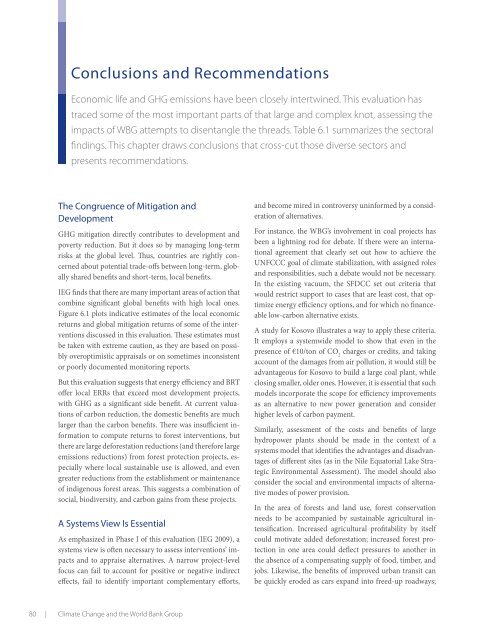The Challenge of Low-Carbon Development - World Bank Internet ...
The Challenge of Low-Carbon Development - World Bank Internet ...
The Challenge of Low-Carbon Development - World Bank Internet ...
Create successful ePaper yourself
Turn your PDF publications into a flip-book with our unique Google optimized e-Paper software.
Conclusions and RecommendationsEconomic life and GHG emissions have been closely intertwined. This evaluation hastraced some <strong>of</strong> the most important parts <strong>of</strong> that large and complex knot, assessing theimpacts <strong>of</strong> WBG attempts to disentangle the threads. Table 6.1 summarizes the sectoralfindings. This chapter draws conclusions that cross-cut those diverse sectors andpresents recommendations.<strong>The</strong> Congruence <strong>of</strong> Mitigation and<strong>Development</strong>GHG mitigation directly contributes to development andpoverty reduction. But it does so by managing long-termrisks at the global level. Thus, countries are rightly concernedabout potential trade-<strong>of</strong>fs between long-term, globallyshared benefits and short-term, local benefits.IEG finds that there are many important areas <strong>of</strong> action thatcombine significant global benefits with high local ones.Figure 6.1 plots indicative estimates <strong>of</strong> the local economicreturns and global mitigation returns <strong>of</strong> some <strong>of</strong> the interventionsdiscussed in this evaluation. <strong>The</strong>se estimates mustbe taken with extreme caution, as they are based on possiblyoveroptimistic appraisals or on sometimes inconsistentor poorly documented monitoring reports.But this evaluation suggests that energy efficiency and BRT<strong>of</strong>fer local ERRs that exceed most development projects,with GHG as a significant side benefit. At current valuations<strong>of</strong> carbon reduction, the domestic benefits are muchlarger than the carbon benefits. <strong>The</strong>re was insufficient informationto compute returns to forest interventions, butthere are large deforestation reductions (and therefore largeemissions reductions) from forest protection projects, especiallywhere local sustainable use is allowed, and evengreater reductions from the establishment or maintenance<strong>of</strong> indigenous forest areas. This suggests a combination <strong>of</strong>social, biodiversity, and carbon gains from these projects.A Systems View Is EssentialAs emphasized in Phase I <strong>of</strong> this evaluation (IEG 2009), asystems view is <strong>of</strong>ten necessary to assess interventions’ impactsand to appraise alternatives. A narrow project-levelfocus can fail to account for positive or negative indirecteffects, fail to identify important complementary efforts,and become mired in controversy uninformed by a consideration<strong>of</strong> alternatives.For instance, the WBG’s involvement in coal projects hasbeen a lightning rod for debate. If there were an internationalagreement that clearly set out how to achieve theUNFCCC goal <strong>of</strong> climate stabilization, with assigned rolesand responsibilities, such a debate would not be necessary.In the existing vacuum, the SFDCC set out criteria thatwould restrict support to cases that are least cost, that optimizeenergy efficiency options, and for which no financeablelow-carbon alternative exists.A study for Kosovo illustrates a way to apply these criteria.It employs a systemwide model to show that even in thepresence <strong>of</strong> €10/ton <strong>of</strong> CO 2charges or credits, and takingaccount <strong>of</strong> the damages from air pollution, it would still beadvantageous for Kosovo to build a large coal plant, whileclosing smaller, older ones. However, it is essential that suchmodels incorporate the scope for efficiency improvementsas an alternative to new power generation and considerhigher levels <strong>of</strong> carbon payment.Similarly, assessment <strong>of</strong> the costs and benefits <strong>of</strong> largehydropower plants should be made in the context <strong>of</strong> asystems model that identifies the advantages and disadvantages<strong>of</strong> different sites (as in the Nile Equatorial Lake StrategicEnvironmental Assessment). <strong>The</strong> model should alsoconsider the social and environmental impacts <strong>of</strong> alternativemodes <strong>of</strong> power provision.In the area <strong>of</strong> forests and land use, forest conservationneeds to be accompanied by sustainable agricultural intensification.Increased agricultural pr<strong>of</strong>itability by itselfcould motivate added deforestation; increased forest protectionin one area could deflect pressures to another inthe absence <strong>of</strong> a compensating supply <strong>of</strong> food, timber, andjobs. Likewise, the benefits <strong>of</strong> improved urban transit canbe quickly eroded as cars expand into freed-up roadways;80 | Climate Change and the <strong>World</strong> <strong>Bank</strong> Group
















